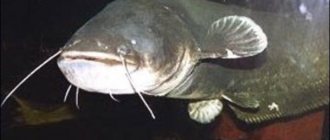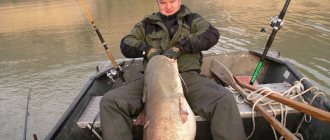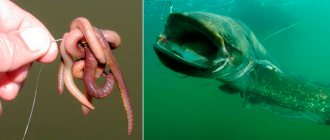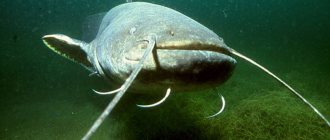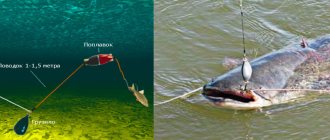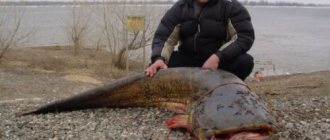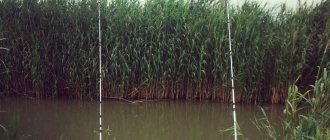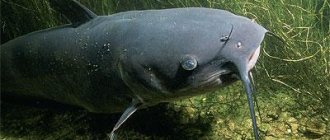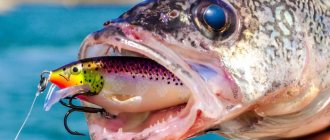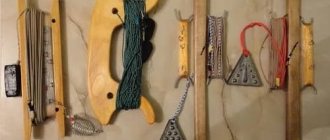For fishermen in the middle zone, catfish is one of the most coveted trophies. This is primarily due to the fact that this fish is the largest inhabitant of our reservoirs. Trophy hunters often catch specimens weighing 20, 30, and sometimes more kilograms, and such fish can bring a lot of pleasure when fishing. A variety of gear is used for fishing for catfish - spinning rods, bottom fishing rods, hooks and much more. However, artificial baits for the river giant often turn out to be unattractive; spinning anglers have this fish as bycatch, and even then relatively infrequently. An interesting option is a donka with an underwater float. This option has a number of advantages compared to conventional equipment.
Tackle design features
As the name of this rig suggests, the main feature is the underwater float. It is this that provides additional mobility to the bait or live bait (and does not serve to display a bite), which has a positive effect on their attractiveness for the main purpose of fishing. An underwater float for catfish looks like a cylinder or an elongated ellipse (this shape makes it suitable for use both in currents and in still water), and is made of materials that have positive buoyancy. Often this is cork, foam plastic or other polymer materials, which makes it possible to independently produce such gear. Mountings for such floats are used both with a sliding sinker and blind ones. There are fishermen who prefer to use rather heavy stones (from 2 kilograms or more) instead of a weight. This ensures that the gear is self-hooking, but such equipment will have to be transported to the fishing site by boat. The stone is tied with a relatively thin rope made of natural materials and attached to the equipment with a thin breaking line, which breaks when a catfish bites, and such a heavy sinker does not interfere with the process of fishing for the trophy. This option is used infrequently, since the use of such a load is quite inconvenient and requires the fisherman to have a swimming device. Important! The sinker can be either sliding or tightly fixed, but the float should not slide along the equipment.
DIY underwater float for catfish – Fishing selections
As the name of this rig suggests, the main feature is the underwater float. It is this that provides additional mobility to the bait or live bait (and does not serve to display a bite), which has a positive effect on their attractiveness for the main purpose of fishing.
An underwater float for catfish looks like a cylinder or an elongated ellipse (this shape makes it suitable for use both in currents and in still water), and is made of materials that have positive buoyancy.
Often this is cork, foam plastic or other polymer materials, which makes it possible to independently produce such gear. Mountings for such floats are used both with a sliding sinker and blind ones.
There are fishermen who prefer to use rather heavy stones (from 2 kilograms or more) instead of a weight. This ensures that the gear is self-hooking, but such equipment will have to be transported to the fishing site by boat.
The stone is tied with a relatively thin rope made of natural materials and attached to the equipment with a thin breaking line, which breaks when a catfish bites, and such a heavy sinker does not interfere with the process of fishing for the trophy.
This option is used infrequently, since the use of such a load is quite inconvenient and requires the fisherman to have a swimming device. Important.
The sinker can be either sliding or tightly fixed, but the float should not slide along the equipment.
Catching catfish from the shore to the bottom - tackle, bait and fishing techniques
Almost every angler sooner or later comes to the goal of catching a trophy specimen. And sometimes the most desirable prey in this case is catfish.
As practice shows, bottom tackle provides the best results when hunting catfish.
Gear selection
Depending on the terrain and fishing conditions, the following are used:
- bottom tackle with a rod;
- Donka without a rod;
Kwok and trolling are the most effective ways to catch catfish. But, unfortunately, not all fishermen have a boat, so many are forced to catch the owner of the river from the shore, using bottom gear. Well, with the right approach, coastal fishing can be very productive - you can catch a decent catch.
Catfish are caught mainly in rivers using donkeys. The most promising places for fishing are holes and exits from them. Catfish loves depth, so it is simply pointless to look for it in any other places.
Throughout the day, river monsters rest calmly at the bottom, buried in the silt, or hiding under some snags. But with the onset of dusk, catfish become more active and go hunting. Therefore, you need to catch catfish at night.
If the place is chosen well, the bites will not take long to arrive. The most important thing is that the tackle does not let you down. This, as well as the best bait for catching catfish, will be discussed below.
Tackle
Catching catfish with a donk has been practiced since time immemorial. Our grandfathers caught the mustachioed one with donkeys, and I must say, they caught it well! They made the snacks with their own hands, using improvised materials.
Wooden pegs with two wire hooks were used as a reel; an ordinary metal bell or a simple plumb line made of clay or lead acted as a signaling device.
Donka-zakidushka is a kind of catfish classic, and is still used by some anglers as the most budget-friendly and easiest option to catch this fish with your own hands.
I won’t talk about how to make a donkey for catfish in the form of a hook, because I don’t think such tackle is relevant in our time. Low cost is the only advantage of such gear over a donkey assembled on the basis of a rod and reel.
There are simply a lot of disadvantages. To learn how to cast a rig from your hand far and accurately, you need a lot of practice; there is always a risk of tangling the line while casting. It got caught on some twig, and that’s all - a beard.
At night, in conditions of poor visibility, the likelihood of a failed cast increases many times over. To ensure that the fishing line does not cling to anything, you need to pre-clean the area, which is not always possible due to some time constraints.
When fishing for large fish, there is a risk of not calculating the maximum load on the fishing line, and the catfish will tear the equipment.
When using a rod and reel, there are no such problems, so this option is definitely better, especially for a novice fisherman.
The best option is to use carp gear for catching catfish.
They have all the necessary qualities, allowing you to make long casts and confidently fight large catfish.
If your budget is limited and you can’t afford to buy carp rods and reels, you can use cheap fiberglass two-piece spinning rods with a large cast for catching catfish from the shore.
I recommend paying attention to KAIDA CROCODILE spinning rods with a length of 2.4-3.0 m. At a cheap price, these sticks have a colossal reserve of power and strength.
They can easily cast heavy equipment and forcefully pull large fish.
As for the choice of fishing line, it is best to immediately wind a braided cord with a diameter of 0.35-0.4 mm onto the spool. The well-known, inexpensive Power Pro cord is quite suitable.
Suitable rod and reel
Catching catfish on a donk with an underwater float involves using a fairly powerful rod. It must cope with strong and heavy fish, since the weight of trophies during such fishing is often measured in tens of kilograms. Unlike when fishing for smaller fish, in the case of catfish, inexpensive Chinese fiberglass telescopic rods will most likely simply not withstand the load. Powerful spinning rods, super-heavy class feeders, as well as some carp rods are suitable for trophy hunting. The action is preferably closer to slow - in this case, almost the entire form will tire the fish.
The reel is also selected based on the possible size of the trophy. This must be a fairly powerful device. It is very desirable to have a baitrunner, as it allows you to safely move away from the rod without fear of losing your tackle. In the absence of such a reel, you can simply release the friction brake as much as possible, however, adjusting the operation of this inertia-free unit during fishing is quite inconvenient. A strong fishing line or cord is also used. If you plan to catch relatively small catfish, then a diameter of 0.3 millimeters may be sufficient, while trophy specimens will require gear with a main line diameter of 0.5 or more millimeters in diameter. Important! You cannot skimp on swivels and fasteners for such gear; they must withstand significant loads.
Preparation and installation of gear for catfish
Fans of catfish fishing are well aware of how unpredictable such an activity can be. Fighting giant prey requires good preparation and effort. And before going to the reservoir, the gear for catfish is selected with special care.
Choosing gear depending on the type of fishing
Being the largest inhabitant of freshwater bodies, catfish can offer strong resistance when fishing. To get it out of the water onto the shore, you need to use strong tackle.
It must withstand not only the large weight of the predator, but also suppress its jerks. The choice of fishing tool depends on the type of fishing.
Gear requirements
When going to the store to buy tackle for catfish, you should choose reliable designs that are ready to cope with any load. There are also a number of requirements that need to be taken into account:
- Rod. It uses powerful fishing rods, adapted for a long fight with a large predator. The best option is a fiberglass model, about 3 m long (if you use longer models, this will complicate the process of controlling the jerks of the fish in the last minutes of fishing). The test load should be 100-300 g for live baits and 100-150 g for artificial products.
- Coil. For catfish fishing, use a reel with a 200 m spool made of durable materials. Experts recommend buying inertia-free models for sea fishing or multipliers. Metal carp reels are suitable for the average catfish.
- Hooks. You can catch catfish with both homemade and factory hooks. The main thing is that they are made of high quality steel. The type of hooks is determined by the size and weight of the bait. So for a large bait, use a large product numbered 8-10, and for meat shells, worms and light baits take a smaller hook (No. 5-6).
- Network. Catfish fishing is carried out using a braided cord with a thickness of 0.35−0.7 mm. Unlike classic fishing line, braided line can withstand loads of up to 30-60 kg. When catching small catfish, the use of fishing line is allowed. Its diameter should be at least 0.6−0.7 mm.
- Leash. It is advisable to use Kevlar models, which have increased flexibility and resistance to strong jerks. The breaking load indicator reaches 50−150 kg. Products made from this material bind well, are not afraid of stretching and are protected from being bitten. A good alternative for a Kevlar leash is a thick fishing line, at least 1 mm thick.
From the shore
You can catch catfish from the shore using either spinning or bottom gear. The second option is considered the most convenient, but does not belong to the category of sports. It involves installing a stationary structure on the shore and waiting for a bite.
When preparing equipment, it is necessary to take into account the specifics and location of fishing. If fishing is carried out in places with an abundance of snags, stumps and other bottom debris, it is better to use a strong fishing line with a reserve.
Single models with a long shank are used as a hook, since they are less likely to get caught on snags. The diameter of the fishing line for donkey is at least 0.6 mm. The optimal weight of the sinker is 200-300 g, and the shape is oval with a longitudinal hole.
The bottom tackle is equipped with a leash 1-1.5 mm long. A good bait for catfish is a live frog. The predator is also interested in the smell of spoiled tripe.
In open water, barbel is caught from early spring until late autumn. Sometimes winter fishing for catfish is allowed, provided that the reservoirs are not covered with ice. But it is difficult to predict how the catfish will behave in winter if its activity decreases greatly during the cold season.
From the boat
The principle of boat fishing is practically no different from shore fishing. At the same time, the presence of a swimming device allows you to change the casting location in the event of a lack of bite.
To attract a trophy, you can use a clever device - “kwok” - catching catfish using this device always brings a good catch. It creates a specific sound that attracts fish from a great distance. The bait used is live bait, frog or crawler.
Spinning tackle
Spinning fishing is considered a difficult activity that involves fighting large prey. To extract a river monster from the water, you need to use powerful, functional and reliable fishing rods with good shock-absorbing properties. When assembling gear for trolling catfish, you should give preference to special models designed for this method of fishing.
Selection of wobblers
One of the most effective baits for catching catfish is a wobbler. Fish are well attracted to both floating and sinking models, and the key requirement is the depth of the product. This property is provided by the manufacturer, but the angler can change the immersion depth of the wobbler himself.
When catching catfish by trolling, you need to consider the following factors:
- Diameter of braided line.
- Distance between boat and bait.
- The speed of the boat.
The bait will be submerged to the maximum depth when using a thin line. Fans of trolling fishing prefer the following models of wobblers: Rapala Super Shad Rap, Mann's Stretch, Halco Sorcerer and Bomber Deep Down Long A.
The listed wobblers for catfish demonstrate good effectiveness due to the wide variety of colors, stable and attractive play, as well as good immersion depth. And according to experienced spinning anglers, a “bomber” wobbler for catfish is the best solution in its price category, allowing you to attract even lazy fish.
Spoons
Every angler's arsenal should include catchable lures for catfish. Particular attention is paid to thick-walled models with large dimensions and heavy weight.
The bait is slowly pulled along the bottom, causing the turbidity to rise, which creates an imitation of the movements of live prey.
Coil selection
If you are interested in how to catch catfish, you need to carefully select a reel. It uses a reinforced product with a spool capacity of up to 3000-5000. At the same time, the predator is caught with both powerful carp reels and models for sea fishing.
For catching catfish by trolling, both power multipliers and inertia-free structures are allowed.
Rod
An important element of equipment for catfish is the fishing rod. It should be as durable as possible, able to withstand strong and aggressive jerks. The optimal length is 2.7−3 m, and the test is 20−60 g. Preference is given to forms with a fast action.
Hooks
To catch catfish with live bait or artificial bait, you must use high-quality hooks. They must be made of durable materials, have sufficient size and degree of sharpening. You can use both store-bought and homemade hooks for catfish (The size of the hooks is determined by the size of the expected catch).
If you expect to catch 5-kilogram specimens, you can get by with carp hooks. Larger predators are caught with hooks numbered 5,9, 10 and larger, depending on their weight. You can't skimp on these products.
Installation
At the stage of installation of gear for catching catfish with spoons or live bait, the reel is equipped with a strong fishing cord or fishing line, 200 m long. A load is fixed at the end of the main line, and a leash and hooks are attached at a distance of 50 cm from the load.
Swivels or carabiners are used as fastening elements. Fishermen also advise installing a leash with a forged hook, instead of a single product.
Other types of gear for catfish
In addition to classic gear, homemade structures are used to catch catfish from a boat and shore. Some homemade products are superior to store-bought ones due to their ability to handle any kind of prey.
Equipment with underwater float
For many years, to catch the predator, fishermen used a clever tackle - a donk with an underwater float. Its distinctive feature is the location of the float.
Unlike classic bottom fishing, here this part of the equipment is under water, providing additional play for artificial bait or live bait.
The design is a small cylinder or an elongated ellipse, which can be used both in still water and under strong currents. The underwater float is made of materials with good buoyancy, including:
- Cork.
- Styrofoam.
- Other polymer raw materials.
It is not difficult to install a catfish tackle with an underwater float. All materials and available tools are available in the home workshop, and you do not need to use additional equipment to assemble them.
Changeover
Catching catfish in spring or autumn is carried out using a net. This design is made from a durable cord equipped with one and a half meter leashes with hooks. The tackle is pulled from one bank to the other across the river. There are bottom and top models.
The first option is equipped with an additional weight that ensures fixation of the nozzle at the very bottom. The harnesses are stretched over the water or along the surface of the reservoir so that the hooks and bait are at a distance of 30-40 cm from the water.
Spear fishing
Today, such a direction as underwater hunting is actively developing. The use of a harpoon allows you to catch a trophy barbel that is large in size and weight.
Catfish activity increases in mid-May, when the water temperature rises to +17...+18°C. During this period, predators begin to spawn, but there is an official ban on fishing in the country. You can start hunting only after spawning has completed, somewhere in early summer.
With the arrival of summer heat, the river water becomes cloudy, so finding prey in it is problematic. Experienced spearfishers consider autumn to be the best time to dive. Autumn cold improves visibility underwater, providing better conditions for your next dive.
In the fall, hunting river catfish is much easier and more effective. In addition, at this time the largest representatives of the species emerge from the pits, which makes the hunt especially exciting.
Often an underwater gun is used to catch catfish in winter. This is possible under favorable weather conditions, when reservoirs remain open from ice.
Pulse fishing rod
There are less common fishing methods that are prohibited by law, but are still used by unscrupulous fishermen. Among them is the use of an impulse fishing rod. The tackle generates an electrical impulse that affects defenseless fish, killing it instantly.
In addition to large individuals, fry and young fish float to the surface. Many of them die, but the rest are damaged and can no longer reproduce.
What homemade tackle is easiest to assemble with your own hands?
It’s not difficult to assemble homemade gear for fishing for catfish. But some options have an intricate design and require installation skills. The rest are quite simple to make, so even a beginner can make them.
Among them is the classic donka. To create the tackle you will need a strong cord, a large hook and a heavy sinker. The latter equipment is cast independently from lead or purchased at a fishing store.
Particular emphasis is placed on the quality of the fishing line. For a homemade product, use a twisted or braided cord that can withstand loads of up to 50-60 kg. The optimal fishing line length is 50−100 m.
Single but large models made of 5-6 mm strong wire are used as hooks.
It’s not difficult to set up catfish supplies with your own hands. It is enough to prepare the necessary equipment elements and connect them one by one. A good homemade product allows you to catch catfish in winter and summer with equal efficiency.
Best lures
When choosing bait for a hook, you need to remember the myopia of the river monster. Possessing poor eyesight, the catfish demonstrates a good sense of smell, hearing and sensitivity of the sides, with which it detects any fluctuations in the water column.
For fishing, you should use moving baits with an intense smell.
Medvedka
Experienced fishermen have been catching barbel with a mole cricket for a long time. The attachment has some advantages that make it better than other options.
Firstly, it is interesting only for catfish, and causes a strong appetite in the predator. Secondly, unlike the crawler, it can stay in the water at any time of the day or night. The river giant responds well to both living and dead mole crickets.
The bait is put on face down. To do this, you need to take it by the body and pierce it with a hook in the neck area with the sting down. Given the aggressive behavior of mole crickets, they cannot be stored in the same container. Each animal is placed in a separate jar of grass and transferred to the refrigerator.
Liver
One of the most effective baits for catfish is chicken liver. However, it does not hold well on the hook, so it attracts fish for a short time. To improve the fixation of the liver, it can be frozen in the refrigerator. The melted product can be placed in a nylon stocking so that it does not crumble in the water.
Soap
In Soviet times, catfish were caught using laundry soap. Then it was created on the basis of animal components without adding aromatic additives.
The composition of modern soap has changed, so the chances of catching a barbel on a piece of such a substance are minimal. In some conditions, the bait justifies itself, provoking the catfish to bite.
Frog
A frog is a classic bait for any catfish fishing. Bait can be found in any pond, but it cannot live long without air underwater. Therefore, before going fishing, it is better to stock up on a large number of frogs in order to change them as activity decreases.
Catching catfish with a donk, feeder, spinning rod, “kwok” and other mentioned gear is always accompanied by unforgettable emotions and a surge of adrenaline.
You never know what kind of monster might be on the hook or how long it will take to fight it, so the time and effort spent is justified by the trophy catch.
Source: https://ribaku.info/snasti/na-soma-2
Baits
Usually the most popular options for catching catfish are used - a bunch of crawlers or leeches, dead fish, pieces of fish, frogs or live bait. If targeted fishing for this particular river giant is carried out, then the amount of bait on the hook and the size of the live bait must match. Because otherwise, instead of the purpose of fishing, smaller predators like pike or pike perch will regularly bother you, and when using worms, even bream. Most anglers will only be happy with such a bycatch, but when hunting for a trophy, baits are needed as large as possible in order to cut off bites from smaller fish.
Advantages of bottom fishing with an underwater float
Adding an underwater float to the design of equipment for bottoms ensures: • More active behavior of live bait. When using regular donkeys, live bait often tries to hide at the bottom and becomes unnoticeable to the catfish. An underwater float, with the correct lifting force and leash length, prevents the fish from doing this. • When using baits such as leeches or crawlers, an underwater float also makes them more attractive to fish, especially if there is a current in the pond. Some float models are equipped with special noise capsules, thanks to which they attract fish from a great distance. • An underwater float for catfish also allows you to avoid the frequent tangling of gear when using live bait. • It is worth mentioning separately the use of a heavy stone as a sinker. Catching catfish with a float, which is located under water, often requires the use of large live bait (sometimes the weight of the fish is more than 500 grams). A heavy stone makes it possible to use a large fish without fear that it will drag away the equipment, and also ensures self-hooking when biting.
Bottom fishing for catfish using an underwater float
For fishermen in the middle zone, catfish is one of the most coveted trophies. This is primarily due to the fact that this fish is the largest inhabitant of our reservoirs. Trophy hunters often catch specimens weighing 20, 30, and sometimes more kilograms, and such fish can bring a lot of pleasure when fishing.
A variety of gear is used for fishing for catfish - spinning rods, bottom fishing rods, hooks and much more. However, artificial baits for the river giant often turn out to be unattractive; spinning anglers have this fish as bycatch, and even then relatively infrequently. An interesting option is a donka with an underwater float.
This option has a number of advantages compared to conventional equipment.
Tackle design features
As the name of this rig suggests, the main feature is the underwater float. It is this that provides additional mobility to the bait or live bait (and does not serve to display a bite), which has a positive effect on their attractiveness for the main purpose of fishing.
An underwater float for catfish looks like a cylinder or an elongated ellipse (this shape makes it suitable for use both in currents and in still water), and is made of materials that have positive buoyancy.
Often this is cork, foam plastic or other polymer materials, which makes it possible to independently produce such gear. Mountings for such floats are used both with a sliding weight and blind ones. There are fishermen who prefer to use rather heavy stones (from 2 kilograms or more) instead of a weight.
This ensures that the gear is self-hooking, but such equipment will have to be transported to the fishing site by boat. The stone is tied with a relatively thin rope made of natural materials and attached to the equipment with a thin breaking line, which breaks when a catfish bites, and such a heavy sinker does not interfere with the process of fishing for the trophy.
This option is used infrequently, since the use of such a load is quite inconvenient and requires the fisherman to have a swimming device.
Important! The sinker can be either sliding or tightly fixed, but the float should not slide along the equipment.
Suitable rod and reel
Catching catfish on a donk with an underwater float involves using a fairly powerful rod. It must cope with strong and heavy fish, since the weight of trophies during such fishing is often measured in tens of kilograms.
Unlike when fishing for smaller fish, in the case of catfish, inexpensive Chinese fiberglass telescopic rods will most likely simply not withstand the load. Powerful spinning rods, super-heavy class feeders, as well as some carp rods are suitable for trophy hunting.
The action is preferably closer to slow - in this case, almost the entire form will tire the fish.
The reel is also selected based on the possible size of the trophy. This must be a fairly powerful device. It is very desirable to have a baitrunner, as it allows you to safely move away from the rod without fear of losing your tackle.
If such a reel is not available, you can simply release the friction brake as much as possible, but it is quite inconvenient to regulate the operation of this inertia-free unit during fishing. A strong fishing line or cord is also used.
If you plan to catch relatively small catfish, then a diameter of 0.3 millimeters may be sufficient, while trophy specimens will require gear with a main line diameter of 0.5 or more millimeters in diameter.
Important! You cannot skimp on swivels and fasteners for such gear; they must withstand significant loads.
Baits
Usually the most popular options for catching catfish are used - a bunch of crawlers or leeches, dead fish, pieces of fish, frogs or live bait. If targeted fishing for this particular river giant is carried out, then the amount of bait on the hook and the size of the live bait must match.
Because otherwise, instead of the purpose of fishing, smaller predators like pike or pike perch will regularly bother you, and when using worms, even bream.
Most anglers will only be happy with such a bycatch, but when hunting for a trophy, baits are needed as large as possible in order to cut off bites from smaller fish.
Advantages of bottom fishing with an underwater float
Adding an underwater float to the design of equipment for bottoms ensures:• More active behavior of live bait. When using regular donkeys, live bait often tries to hide at the bottom and becomes unnoticeable to the catfish. An underwater float, with the correct lifting force and leash length, prevents the fish from doing this.
• When using baits such as leeches or crawlers, an underwater float also makes them more attractive to fish, especially if there is a current in the reservoir. Some models of floats are equipped with special noise capsules, thanks to which they attract fish from a great distance.
• An underwater float for catfish also allows you to avoid the frequent tangling of gear when using live bait.
• It is worth mentioning separately the use of a heavy stone as a sinker. Catching catfish with a float, which is located under water, often requires the use of large live bait (sometimes the weight of the fish is more than 500 grams). A heavy stone makes it possible to use a large fish without fear that it will drag away the equipment, and also ensures self-hooking when biting.
Self-production
Making tackle for catfish with your own hands is not difficult. Suitable materials for manufacturing include light wood, cork, foam, foam rubber and other porous polymer materials.
The workpiece must be given a streamlined shape and pierced with a plastic tube, inside which the fishing line will pass.
To attach a sinker to such a float, put on and tighten a plastic clamp (this is usually used to connect several cables together), into which a swivel with a carabiner is first threaded. Such products work no worse than store-bought ones.
Tactics
The most successful point for fishing with such equipment will be the exit from a deep hole, or the deepest pools. The tackle is thrown to a promising point (in the case of using a stone as a sinker, it is brought in by boat). Particularly promising are those sections of the river where there are snags or other shelters near the hole at the bottom.
The process of catching a large catfish is a leisurely affair, bites occur quite rarely, which makes it necessary to use different types of bite alarms. Sometimes during such fishing they use supplementary feeding, which should attract the catfish to the fishing point. Worms, both whole and chopped, pieces of fish, and bird giblets are used.
The bait is mixed with the soil, balls are formed, and the fishing point is fed with them. This not only attracts catfish, but also distracts smaller fish, which often try to pull even large bait off the hook.
I also use soil for a reason - adding plant components will attract white matter, but it will not be interesting for the fishing object.
You should not hunt for trophy catfish alone. As a rule, they fish with more than one rod, and in the event of a bite with two at once, an unpleasant choice may arise - to lose a trophy or tackle, which a river giant can easily drag into the water. And at the end of fishing, the help of a partner with a landing net or hook will be very useful.
Source
You may also be interested
Source: https://catcher.fish/ekspertnyi-tsentr/fishexpert/donnaya-lovlya-soma-s-ispol-zovaniem-podvodnogo-poplavka/
Self-production
Making tackle for catfish with your own hands is not difficult. Suitable materials for manufacturing include light wood, cork, foam, foam rubber and other porous polymer materials. The workpiece must be given a streamlined shape and pierced with a plastic tube, inside which the fishing line will pass. To attach a sinker to such a float, put on and tighten a plastic clamp (this is usually used to connect several cables together), into which a swivel with a carabiner is first threaded. Such products work no worse than store-bought ones.
Tactics
The most successful point for fishing with such equipment will be the exit from a deep hole, or the deepest pools. The tackle is thrown to a promising point (in the case of using a stone as a sinker, it is brought in by boat). Particularly promising are those sections of the river where there are snags or other shelters near the hole at the bottom. The process of catching large catfish is a leisurely affair; bites occur quite rarely, which makes it necessary to use different types of bite alarms. Sometimes during such fishing they use feeding, which should attract the catfish to the fishing point. Worms, both whole and chopped, pieces of fish, and bird giblets are used. The bait is mixed with the soil, balls are formed, and the fishing point is fed with them. This not only attracts catfish, but also distracts smaller fish, which often try to pull even large bait off the hook. I also use soil for a reason - adding plant components will attract white matter, but it will not be interesting for the fishing object. You should not hunt for trophy catfish alone. As a rule, they fish with more than one rod, and in the event of a bite with two at once, an unpleasant choice may arise - to lose a trophy or tackle, which a river giant can easily drag into the water. And at the end of fishing, the help of a partner with a landing net or hook will be very useful.
